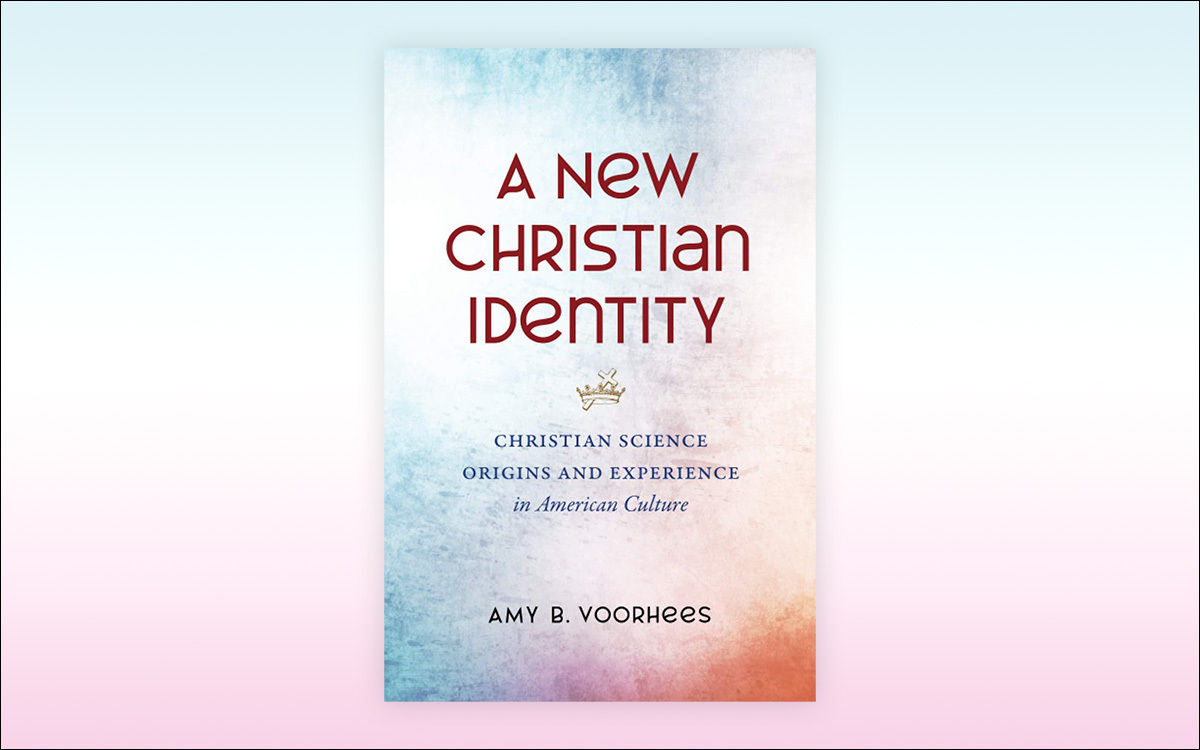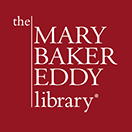Book review: A New Christian Identity
By Timothy C. Leech

Everyone interested in the history of Christian Science and its founder should know about an important book released last year by religious studies scholar Amy B. Voorhees.1 A New Christian Identity: Christian Science Origins and Experience in American Culture helps address a great need for the academic community to have accurate information about Christian Science.
One of my experiences in graduate school illustrates this pressing need. I was speaking with a professor who specializes in nineteenth-century American women’s history, about my interest in Mary Baker Eddy and the early history of Christian Science. She told me she was aware of only two things about Eddy. She knew of a biography by a feminist scholar that had recently been released.2 And she repeated the incorrect contention that Eddy had appropriated all that made Christian Science unique from a magnetic healer in Maine.3 A New Christian Identity should help correct such misinformation on Christian Science history, which remains prevalent among some scholars. Issued by the University of North Carolina Press—a well-respected publisher, especially in American history—the book is clearly aimed at academic readers, who will relate particularly to its language, presentation, and style.
Voorhees summarizes her main argument in the title. The emergence of Christian Science in the decades around the year 1900 constituted a new sense of religious identity for adherents. While this probably comes as no great surprise to members of the Christian Science community, it may be a ground-breaking insight for many scholars of American religious studies.
A New Christian Identity covers three broadly thematic topics. The first involves a brief intellectual and theological biography of Eddy. The second, drawing heavily on Voorhees’s doctoral dissertation, is an examination of the process Eddy undertook to revise and edit her main work, Science and Health with Key to the Scriptures.4 In covering that writing and revising, Voorhees takes into account the various challenges to Eddy’s discovery that she had to address at the same time. Finally, Voorhees examines the diverse life-experiences of early-generation Christian Scientists, to show how their religious movement constituted, for them, a new Christian identity. Each of these topics represents a major research project and constitutes its own substantial contribution. The fact that she effectively addresses all three in this relatively slim volume is a testament to editorial discipline.
While the general outlines of Eddy’s biography are familiar to most Christian Scientists, Voorhees shares some eye-opening insights and discoveries. For example, we learn that the term Christian science was relatively common in early nineteenth-century intellectual discourse, despite its having mostly disappeared by the Civil War era. Various thinkers used the term to express different ideas. But none approached the meaning that Eddy eventually applied to it. Also, Voorhees sees Eddy’s 1864 healing of Mary Ann Jarvis as an important turning point that inspired Eddy to pursue her own healing practice. 5 Jarvis was the patient whom Eddy described in Science and Health as having great difficulty breathing when the winds were from the east.6
As well, A New Christian Identity references Reverend A. J. Gordon, mentioned in Eddy’s biographies as a prominent Boston minister who criticized Christian Science as being unchristian. Gordon’s colleague Reverend Joseph Clark grudgingly allowed Eddy to make a brief response to this attack at one of his lectures.7 In her research, Voorhees draws a more nuanced picture of Gordon. He was a pioneer in an American protestant movement that sought to restore divine healing to Christian practice. Unlike Christian Science, Gordon expected this renewed healing ministry to conform to traditional Protestant doctrines—and remain subservient to the authority of the male clergy. 8 This context helps us understand that Christian Science arrived on the scene when many Americans were seeking the restoration of Christian healing.
As Voorhees notes, Christian Scientists are a “people of the book.”9 But unlike other foundational religious texts, Science and Health is known to have been extensively revised and edited by its author at several points in its publication history. Voorhees traces Eddy’s process of editing Science and Health, especially concentrating on the episodes of major reworking that took place between its first appearance, in 1875, and the landmark 50th edition, published in 1891. By then the book’s language and major chapter titles had arrived at a form resembling the final version. Throughout the rest of her life, Eddy continued to rearrange the chapters and titles, made alterations and additions, and added the chapter titled “Fruitage.” Christian Scientists may very well find the section on the revisions of Science and Health to be the most interesting part of A New Christian Identity. Voorhees points out that Eddy was consistent in her claim that there was one discovery of Christian Science and that Science and Health is the only complete statement of it; also that Eddy devoted considerable effort to ensuring that the statement contained within the book was as clear and accessible as possible. As Voorhees observes, Eddy “called her book the best healer and biblical interpreter and thus her movement’s ‘only standard’ in its distinctive Jesus-following efforts.”10
Exploring her book’s third major topic, Voorhees departs from the biographical focus on Eddy and Science and Health, to identify Christian Scientists through the first decades of the twentieth century. For many generations, white men held the privileged positions in academic work in the social sciences, both as practitioners and objects of scholarship. In recent decades, studies of history, human society, and culture—including religious studies—have cast a more inclusive net, seeking to account for the experiences of those with different racial and gender backgrounds. Identity has become a central topic for study. Who people were, how they identified, what was important to that sense of identity—these questions are all central for this scholarly trend.
In her research on the identities of early Christian Scientists, Voorhees does an admirable job of engaging with, and expanding on, this scholarship, conducting a meticulous reading of testimonials, articles, and other items published in the Christian Science periodicals. These pieces are primarily either metaphysical discussions or accounts of how Christian Science healed various problems. But they also provide evidence about other aspects of people’s experiences and identities. It takes a discerning eye to glean these details from the periodicals. This enables Voorhees to tell us much about who the first Christian Scientists were.
She highlights two aspects concerning the identities of North American Christian Scientists in the first 50 years of their religion. First, she challenges the stereotype of a religion made up of middle-class and upper-class white people. Women and men from African American and Latin American ethnicities, as well as a variety of class backgrounds, joined the growing Christian Science movement. Second, she observes that Christian Science offered far more than merely the healing of physical, economic, emotional, and relationship difficulties—many people expressed gratitude for the spiritual growth and uplifted outlook on life the new religion offered. At the same time, it afforded them membership in a community of people from diverse backgrounds, who all shared in working toward a higher and more spiritual understanding of existence.
In a recent essay for The Mary Baker Eddy Library, Voorhees introduces those of us not embedded in the academic field of religious studies to the term scholar-practitioner.11 This signifies a person who is both an academic student of a particular religion and a member (or practitioner) of that religion. In A New Christian Identity, Voorhees presents well-researched evidence and makes balanced, objective, and rigorous arguments. Nothing in the book discloses her identity as a scholar-practitioner—both a scholar of Christian Science and a member of the church.
A New Christian Identity is worth reading, even if some may find its dense academic language challenging. This is an important contribution to the scholarship on Christian Science and its early history. I am extremely grateful that this book is now available, so I can recommend it to my scholarly colleagues.
Timothy C. Leech is an independent scholar currently based in Ontario, Canada. He received his PhD in American history from The Ohio State University. His prior experiences include graduate studies at Harvard University and employment as a researcher and curator at the inception of The Mary Baker Eddy Library.
- Amy B. Voorhees, A New Christian Identity: Christian Science Origins and Experience in American Culture (Chapel Hill: The University of North Carolina Press, 2021).
- Apparently this was a reference to Gillian Gill’s Mary Baker Eddy, part of the Radcliffe Biography Series (Reading, Massachusetts: Perseus Books, 1998).
- For thorough and up-to-date research on this issue, see Keith McNeil, A Story Untold: A History of the Quimby-Eddy Debate, 3 vols. (Carmel, Indiana: Hawthorne Publishing, 2020; 2016 first e-book publication).
- Amy Black Voorhees, “Writing Revelation: Mary Baker Eddy and Her Early Editions of Science and Health, 1875–1891” (Santa Barbara: University of California, 2013).
- Voorhees, A New Christian Identity, 50–51.
- See Mary Baker Eddy, Science and Health with Key to the Scriptures (Boston: The Christian Science Board of Directors), 184–185.
- See the Mary Baker Eddy Library, “What is the Historical Background of No and Yes by Mary Baker Eddy?” 7 February 2014, https://www.marybakereddylibrary.org/research/historical-background-no-and-yes/
- Voorhees, A New Christian Identity, 140, 142–145.
- Voorhees, A New Christian Identity, 227.
- Voorhees, A New Christian Identity, 169.
- Amy B. Voorhees, “The work of Jean McDonald: an appreciation,” 22 November 2021, https://www.marybakereddylibrary.org/research/the-work-of-jean-mcdonald-an-appreciation/

